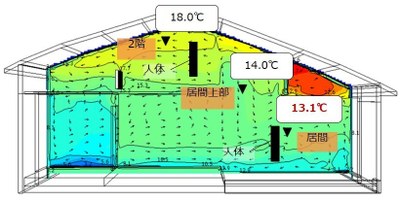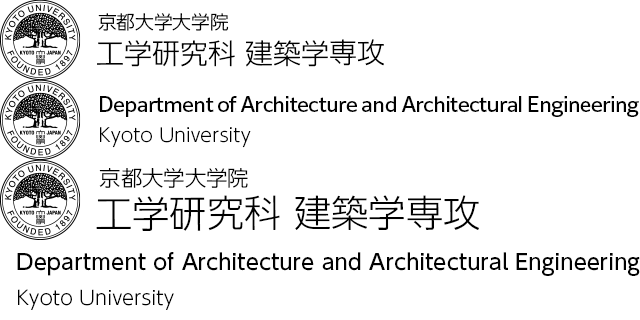Building Environment Control
This laboratory is aimed at developing methodologies to achieve healthy, comfortable, and safe indoor environment with considering global environmental impacts. Our research is based on the fundamental principles and applied technologies concerning heat, moisture, and air transfer. Furthermore, we study methods to preserve and exhibit cultural properties by properly controlling their surrounding environments. We also research theories and planning methods pertaining to building equipments in order to achieve required environmental conditions.
Academic Staff
Daisuke OGURA
 Professor (Graduate School of Engineering)
Professor (Graduate School of Engineering)
Research Topics
To promote comfortable and healthy dwelling spaces and to preserve cultural heritage, I focus on heat and moisture problems in relation to architecture and cultural heritages.
In recent years, I have been studying the following topics:
- Evaluation and improvement of thermal environment with considering health and comfort in dwellings and vernacular architecture in Asian hot and humid regions
- Use of hygroscopic materials to provide moisture buffering in indoor climates
- Durability prediction and effective use of super insulation materials
- Preservation of mural paintings in various world cultural heritages
- Preservation of stone cultural properties such as tumulus and stone Buddha
Contacts
Room 405, Bldg. C2, Katsura Campus
TEL: +81-75-383-2918
FAX: +81-75-383-2966
E-mail: ogurad![]() archi.kyoto-u.ac.jp
archi.kyoto-u.ac.jp
Chiemi IBA
Associate Professor (Graduate School of Engineering)
Research Topics
My main research topics include residential thermal environments and the durability of building materials.
Current research themes are as follows:
- Field survey of frost damage and analysis of freezing-thawing processes in building materials
- Thermal environment control and energy savings in Kyo-machiya with considering residential health and comfort
- Investigation of moisture buffering effect of interior materials
- Energy conservation of hot water supply systems
Contacts
E-mail: iba![]() archi.kyoto-u.ac.jp
archi.kyoto-u.ac.jp
Nobumitsu TAKATORI
Assistant Professor (Graduate School of Engineering)
Research Topics
Focusing on hygrothermal environments, particularly in architecture and cultural properties, I have been studying the following topics.
- Investigation of the mechanism of water and salt transport and stress generation in porous materials during dry-wet cycles
- Preservation and exhibition of cultural properties in semi-outdoor spaces, such as wall paintings and stone Buddha carved into a cliff
Contacts
Room 411, Bldg. C2, Katsura Campus
TEL: +81-75-383-2921
E-mail: takatori.nobumitsu![]() archi.kyoto-u.ac.jp
archi.kyoto-u.ac.jp
Research Topics
1. Thermal environment and energy consumption in dwellings and buildings
We survey the energy consumption and environmental conditions in dwellings and buildings. Based on the survey results, we propose some methods to reduce energy use, to utilize renewable energy, and to control indoor environment, considering such factors as climate and lifestyle.

Fig.1 CFD analysis on the effective heating method in traditional dwellings
2. Evaluation and improvement of thermal environment in vernacular architecture
We survey thermal environmental conditions in vernacular architecture in the world, including Japan. The purpose of our research is the succession of an architecture which makes use of the climate, material, and traditional craftsmanship in the region; therefore we investigate, evaluate and propose an improving plan from a viewpoint of indoor environmental control.

Fig.2 Bure, traditional thatched dwellings in Fiji, and a weather station
3. Comfort and health in sleeping and bathing environments
It is important to maintain the proper thermal environment in both the bedroom and bathroom to promote healthy and comfortable sleeping and safe bathing.
For this purpose, we make efforts to understand the characteristics of human physiology such as body temperature, perspiration rates, and blood pressure. Using this information, we developed a numerical model to estimate the human physiological values.

Fig.3 Measured and predicted blood pressure fluctuation during bathing
4. Environmental control for preservation and exhibition of cultural properties
Cultural properties, such as a mural painting, need to be controlled the environment to suppress as much as possible degradation due to the effects of the temperature, relative humidity, air quality and so on during collection, exhibition, and transportation. We are investigating the environmental control technique for preservation and exhibition of cultural properties.

Fig.4 The view of measurement temperature and humidity inside the simulated Japanese-style sliding door(“Tobusuma”)
5. Preservation of historic buildings and remains
Heritages such as historic buildings and remains are at risk of progression of the deterioration due to the effect of the outdoor temperature and humidity, solar radiation, rainfall and ground water. We are clarifying the mechanism of the degradation and are proposing the preventive and control measures for suppressing degradation as much as possible.

Fig.5 Simulated tumulus in Katsura campus (Left: Exterior, Right: In the stone chamber)
6. Investigation of the deformation and fracture mechanisms of building materials caused by water or salt
Buildings and heritages are subjected to deformation and destruction by water, ice and salt that exist inside the materials. We consider these phenomena through field surveys, experiments, measurements of physical properties and numerical analysis, and investigate the mechanisms of heat, water and salt transfer and how the formation of ice and salt crystals generate the stress. Based on these studies, we propose the methods to prevent and control the deterioration and contribute to longer the durability of buildings and conserve the cultural properties.

Fig.6 Salt weathering of the brick masonry structure
